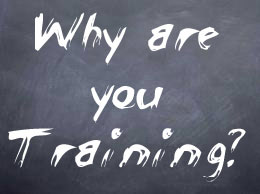
Having been in the fitness industry personally and professionally for over 2 decades I have seen many fitness programs and trends come and go.
One truth stands clear–there is no “one size fits all” training or nutritional program, with a few notable exceptions.
Every effective fitness program no matter the goal or sport must have an element of strength training, metabolic conditioning and flexibility/mobility training. These basic components must be present to make any person/athlete better prepared for their activities of daily living or sport. The goal and assessment will determine the percentage of emphasis on each element.
When designing a training protocol/program several things need to be taken into consideration. First & foremost I ask the question “what are you training for (WAYTF)?” The answer to this question will, to a large degree, determine programming.
Secondly, what are the client’s genetics, experience, limitations, age, recuperative abilities and amount of time allotted to training? After gathering this information during a thorough assessment, I can begin to design their program which over the course of training will need to be reevaluated and adjusted according to how things are going.
While we have ascertained that there is no one size fits all training program, are some fitness regimes actually superior to others?
Absolutely. The best program, by far, I have ever run across to meet many but not all goals is CrossFit. Unfortunately it is sometimes misunderstood and definitely misapplied by some affiliates/trainers. When properly programmed, CF can enable a large variety of people to reach their goals with the proper adjustments and modifications. With this is mind, who is CrossFit for? Only the already “fit”? Hardly.
If your goal is. . .
 General Physical Preparedness: by this I mean you want to be well rounded in all aspects of fitness; such as cardio respiratory endurance, stamina, strength, flexibility, power, speed, coordination, agility, accuracy and balance. This would include most people: military, law enforcement, firefighters, the weekend warrior and the average Jane & Joe.
General Physical Preparedness: by this I mean you want to be well rounded in all aspects of fitness; such as cardio respiratory endurance, stamina, strength, flexibility, power, speed, coordination, agility, accuracy and balance. This would include most people: military, law enforcement, firefighters, the weekend warrior and the average Jane & Joe.- Power Athlete: the football, basketball, soccer, rugby players etc–all anaerobic sports.
- Endurance Athlete: distance runners, triathletes and cyclists.
- Deconditioned, elderly/sick: overweight, out of shape, “mature” people and those with lifestyle related health issues. Many people doing crossfit with these challenges have regained the physical function from 20+ years ago, lost a lot of weight along with reduced most if not all medications. The scalability/modifications when properly applied make it adaptable to all levels. Life changing to say the least.
- Bodybuilder: if the main goal is to be as large as possible and look pretty in the mirror without a care to functionality and health CF training is not optimal for sarcoplasmic hypertrophy. That’s not to say that incorporating some function and basic heavy, low rep compound movements into your training would not improve overall size and strength by inducing myofibrillar hypertrophy. CF is nothing new; “bodybuilders” of old were not doing much isolation work nor did they get their physiques from hours spent on the cable crossover machine but rather from the mass produced by performing the Oly lifts and hoisting atlas stones.
- Fat Loss: often confused with exercise being the main promoter. This is 80% nutrition the other 20% is facilitated by exercise and CF in all its “forms” will do the trick. Just check out the Games competitors–lean and ripped.
Yes, “basic” CrossFit will “punish the specialist” most definitely. With the right modifications, however, it can take many athletes/people where they want to go. While not the only method, CF has taken over as one of the best overall ways to create fitness. Are there any cons? Yes. According to some affiliates/trainers:
- Poor programming: lack of properly designed strength program, too much volume and not offering modifications for scaling.
- Lack of foundational program: failure to insist upon a sound and solid foundational or on ramp program for newcomers. Many of the lifts and movements in CF are technically complex in nature but beneficial. The lifts need to be taught; initially with a pvc or light weight before moving on to a loaded bar.
Improper programming along with a failure to coach can lead to injuries, overtraining, or people feeling intimidated and not wanting to come back, yet we see this with any fitness program–not only with CrossFit. There are great, good and bad boxes/gyms/fitness facilities. You will find that with doctors, lawyers, hairdressers and any profession in general.
In my 2 decades of fitness coaching, I have never seen as many major life transformations as I have with CF. The emphasis on variety, function, community and the mental and physical strength it requires and builds create this transformation.
It works–the exercises (basic movements), the nutrition and the mindset. No one program is for everyone but CF is a program that addresses the goals and needs of a wide range of people. Depending upon what you are training for it may very well be the only one you will ever need.
Stay tuned for the upcoming series on how to train for your different goals with CrossFit. In the meantime give some thought to–WAYTF?
About the Author
Paula Jager CSCS and Level 1 CrossFit and CF Nutrition Certified is the owner of CrossFit Jaguar.
Her exercise and nutrition programs yield life changing results








I am a NASM CPT/PES/CES and MS specialized in Performance enhancement and injury Prevention. I have been looking into crossfit. Proper preparation is a must from reading the crossfit certification manual. My big concern even with me, is making sure I have addressed my imbalances as much as possible, before beginning a oly lifts and other cross fit moves. I would still want the functional movement to be the best it could be. I have experienced the prep for bodybuilding and done it myself. I used a lot of functional movement and periodization (this means I did things to prep, then stabilization, then to build strength, then build mass and then refined the mass and scheduled my time off. These were rotated sometimes daily to get the results I wanted) to get to the physique I had. I have been battling Chronic fatigue and then recently been through 2 minor surgeries and a major, I am still in recovery building the base. I will consider using some of crossfit, but within the abilities I have at the time. I spent long enough in the military to learn how to tear a body down, I am now spending time listening to my body to rebuild and repair it. Listen to your body.
As a newbie (2 months) Crossfitter and former obese, older female, I love Crossfit. Got bored at my globogym (still have my membership for basic working out and cardio), so added this. I am loving every minute of the warmups and WODS AFTER I hate them. ONLY a Crossfitter understands that!! I stay safe but keep getting stronger with every week that passes by. I keep getting asked if I compete in body building. Nope. I just eat right and work out smart! People get injured in every range of fitness training or sports participation. Just be smart.
@ Sheena that’s a funny comment.
I’ve heard some real bad stories and seen some very bad videos of appalling technique where the goal has become beasting yourself to the limit instead of working on ‘general physical preparedness’ — a healthy, functional body.
I’ve mixed feelings about trying a class. My local crossfit gym ask you to do 5 private lessons to work on technique which is a good thing since I’m more a martial artist than an Olympic Lifter but I think those exercises will definitely help my performance.
Crossfit is extremely dangerous – high impact forces are detrimental to the body’s structure. An exercise, when performed properly, should never injure a client. It should be performed in a controlled fashion that limits the stress and force placed on a joint. People who do Crossfit wear their injuries as badges of honour, which is absolutely crazy.